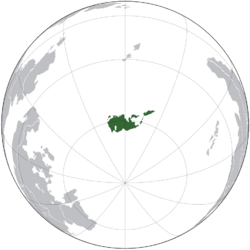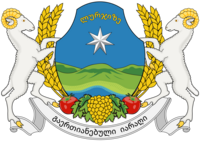Difference between revisions of "Lurjize"
Not Gagium (talk | contribs) m |
Not Gagium (talk | contribs) |
||
| Line 8: | Line 8: | ||
| national_motto = ''გაერთიანებული იარაღი<br />Gaertianebuli Iaraghi'' | | national_motto = ''გაერთიანებული იარაღი<br />Gaertianebuli Iaraghi'' | ||
| englishmotto = {{small|(United in Arms)}} | | englishmotto = {{small|(United in Arms)}} | ||
| − | | national_anthem = | + | | national_anthem = დიდება<br>[[Dideba]]<br>"Glory"<div style="padding-top:0.5em;">{{center|[[File:Dideba (Georgia former anthem) vocal instrumental mix in C major.ogg]]}}</div> |
| royal_anthem = | | royal_anthem = | ||
| image_map = Locator_Lurjize.png | | image_map = Locator_Lurjize.png | ||
Revision as of 22:37, 28 August 2023
Republic of Lurjize ლურჯიზის რესპუბლიკა | |
|---|---|
Motto: გაერთიანებული იარაღი Gaertianebuli Iaraghi (United in Arms) | |
 | |
| Location | Southern Ocean |
| Capital and largest city | Paluri |
| Official languages | Lurjizean |
| Recognised national languages | Lurjizean Creeperian Spanish |
| Ethnic groups (2010) | ??% Lurjizeans ??% Creeperans |
| Religion (2010) | ??% Catholic |
| Demonym(s) | Lurjizean |
| Government | Unitary semi-presidential republic |
| Anri Akhalaia | |
| Tengiz Biniashvili | |
| Legislature | National Congress |
| Independence from Creeperopolis | |
• ??? | ??? |
| 14?? | |
| 1918 | |
| Population | |
• 2021 estimate | 9.4 million |
• 2010 census | 9.5 million |
| GDP (nominal) | 2014 estimate |
• Total | ₵48.4 billion |
• Per capita | ₵5,100 |
| Gini (2014) | 37.4 medium |
| HDI (2017) | high |
| Currency | Lurjizean Viri (LUV) |
| Time zone | AMT+3 to +4 |
| Driving side | left |
| Calling code | +507 |
Lurjize, officially the Republic of Lurjize (Lurjizean: ლურჯიზის რესპუბლიკა; transliteration: Lurjizis Resp’ublik’a), is the sole nation of the Lurjizean landmass located in the Southern Ocean between mainland Sur and the San Carlos Islands.
Contents
Etymology
It is believed that the modern name Lurjize stems from the Lurjizean word ლურჯი (lurji), meaning 'blue.' One running theory is that this was appended onto the Lurjizean word for 'sea', ზღვის (zghvis), but this was shortened over time until it became obsolete by the time of independence from Creeperopolis. Under Creeperian occupation, Lurjize was known as San Esteban, with the landmass being referred to as the Saint Stephen Islands (las Islas de San Estefano). However, even during the roughly five centuries of Creeperian rule, the name Lurjize was widely used amongst the non-Creeperan population.
History
Early settlement
The earliest definitive trace of human activity in the Lurjizean landmass can be traced back to the migration of the Proto-Creeperans from present-day Creeperopolis due to food insecurity caused by the region reaching its carrying capacity before the advent of agriculture in Sur. The extent of which the Proto-Creeperans were a seafaring people are unknown, as well as whether they were aware of the Lurjizean landmass or not. However, starting in around 3,500 BCE, archaeological records suggest that Proto-Creeperian immigration to the Lurjizean landmass began, with this continuing for several centuries. Modern DNA analysis suggests that the Proto-Creeperans would continue migrating east, eventually reaching the San Carlos Islands. Lurjizean historians believe that contact between the indigenous peoples of Lurjize and the San Carlos Islands would continue until Creeperian colonization of Lurjize beginning in the 15th century, though there is no evidence to suggest that later Lurjizean states exchanged language with the San Carlos Islands' indigenous population.

Most anthropologists believe that the Gagsaplavi archaelogical site is the key to understanding early Lurjizean history. Carbon dating suggests that the Gagsaplavi settlement was established sometime around 1,800 BCE on San Estefano Island. At its peak, the Gagsaplavi settlement consisted of several permanent stone buildings, with some anthropologists suggesting that the city had a population of several thousand people. Furthermore, experts argue that the existence of the Gagsaplavi settlement indicates the practice of agriculture by indigenous Lurjizeans, as well as the existence of religion.
By the 5th century, several permanent settlements had risen and fallen in Lurjize, including the city-state of Namarikhi. Carved inscriptions and manuscripts obtained by archaeologists suggest that the Lurjizean language in the Old Lurjizean form came about in Namarikhi sometime around the 400s-700s. However, there is little to suggest that the Lurjizean language had an extensive presence outside of San Estefano Island before Creeperian colonization. Many records of the development of the Lurjizean language were lost as a result of the Creeperian conquest of San Estefano Island, especially during the conquest of Paluri.
Creeperian arrival
Geography
Government and politics
Lurjize is a unitary semi-presidential republic, with the President as the head of state and de facto head of government, and Prime Minister as the de jure head of government. The executive branch of power is made up of the Cabinet of Lurjize, which is appointed and led by the Prime Minister (who himself is appointed and by the National Congress of Lurjize. However, the President exercises the right to remove a Prime Minister at his discretion, though he is not entitled to determining the replacement. Anri Akhalaia is the current President of Lurjize, having won the 2011 Lurjizean presidential election with 74.52% of the vote and securing his reelection in the 2019 Lurjizean presidential election.
The National Congress of Lurjize holds all legislative authority in the country. It is unicameral and has 120 members, known as deputies who are chosen to represent parties by proportional representation. National Congress deputies are elected for four-year terms. The National Progress Front has held control of the National Assembly since 1963, with all modern Presidents and Prime Ministers having been members of the party.
Different opinions exist regarding the degree of political freedom in Lurjize. In their 2022 report, the Global Freedom Network listed Lurjize as a "hybrid regime", which is above the threshold for an authoritarian regime but below the threshold needed to be classified as a flawed democracy. Many political pundits in Ecros and Ostlandet view Lurjize as a de facto authoritarian nation due to the extensive control the National Progress Front has held over the country for the past several decades, as well as high rates of corruption, close ties to the Creeperian government, and lack of civil rights in the nation.


